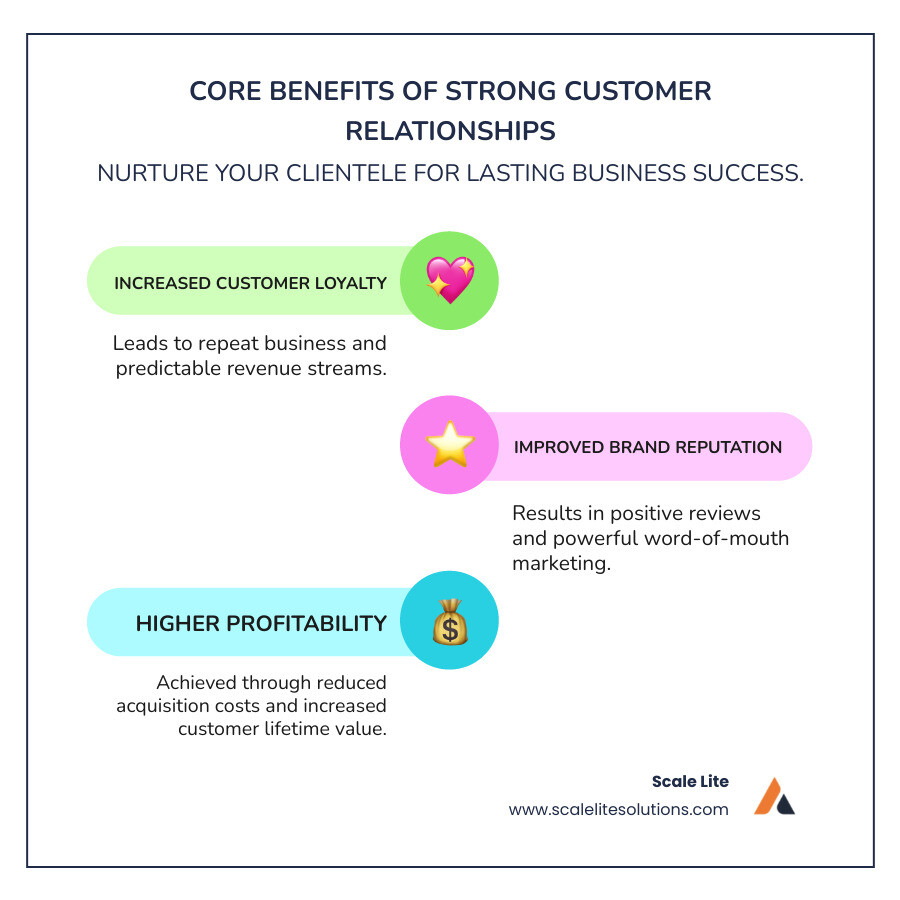
Better Relationships, Better Business: Improving Your CRM Strategy

Why Customer Relationship Management Is Your Business's Hidden Revenue Engine
Improve customer relationship management by focusing on these essential strategies that drive business growth:
- Build genuine connections through personalized communication.
- Use technology smartly to track interactions and automate follow-ups.
- Create loyalty programs that reward repeat customers.
- Gather feedback consistently to identify problems early.
- Empower your team to solve customer problems quickly.
Many business owners overlook a simple truth: maintaining existing clients costs far less than acquiring new ones. Research shows that 90% of Americans use customer service as a deciding factor when choosing a business to work with.
Too often, service businesses treat customer relationships as an afterthought, focusing only on the current job. This misses the opportunity to build loyalty that creates steady, predictable revenue.
Strong customer relationships directly impact your bottom line. Happy customers become repeat customers who refer friends and leave positive reviews. A loyal customer base also significantly increases your business's value when you decide to sell.
I'm Keaton Kay. Through my experience in private equity and helping service businesses modernize, I've seen that companies that improve customer relationship management consistently outperform their competitors. At Scale Lite, I help blue-collar business owners implement systems that turn one-time customers into lifelong advocates.

Quick improve customer relationship management definitions:
The Foundation: Why Strong Customer Relationships Matter
Here's the truth that separates thriving service businesses from those just getting by: being good at your job is only half the battle. The other half is creating genuine connections with your customers.
You might be the best contractor in town, but if customers feel like just another job number, they'll forget you once the work is done. A customer-centric culture, where you put customers at the heart of every decision, changes everything. This means shifting from a reactive mindset (waiting for problems) to a proactive one (anticipating needs), which becomes your secret weapon in a crowded market.
Businesses that improve customer relationship management enjoy higher profit margins. When you master building relationships, customers don't just come back; they become walking advertisements for your business. The old saying is true: it's cheaper to keep a customer than to find a new one. For more insights, check out our guide on Business Growth Strategy.
Customer Relations vs. Customer Service
Many business owners confuse customer relations and customer service. While they sound similar, they represent different approaches to customer interaction.
| Aspect | Customer Relations | Customer Service |
|---|---|---|
| Approach | Proactive: Focuses on building long-term bonds and anticipating future needs. | Reactive: Addresses immediate questions, concerns, or issues as they arise. |
| Time Horizon | Long-term: Aims to foster enduring loyalty and a deep connection. | Short-term: Resolves transactional problems quickly and efficiently. |
| Goal | Relationship-building: Cultivating trust, loyalty, and advocacy. | Problem-solving: Providing solutions and support for specific inquiries. |
| Primary Focus | Nurturing connections, understanding preferences, creating positive overall experiences. | Answering questions, troubleshooting, processing requests, fixing what's broken. |
Think of it this way: customer service fixes what's broken. Customer relations builds the trust that makes customers call you first and recommend you to everyone. Both are vital, but sustainable growth comes from mastering the proactive, relationship-building side.
The Core Benefits of Nurturing Your Clientele
Committing to real customer relationships yields measurable improvements that show up in your bank account.

- Increased customer loyalty: When people feel valued, they stick around. They don't shop for the cheapest quote; they call you first because they trust you.
- Higher customer lifetime value: Loyal customers spend more with you over time, as they are more open to additional services and trust your recommendations.
- Cost savings through retention: Every dollar not spent chasing new customers is a dollar that stays in your pocket. Marketing to strangers is expensive; taking care of existing customers is smart business.
- Positive brand reputation: Happy customers leave glowing reviews and share their experiences. According to research by Microsoft, 90% of Americans consider customer service when choosing a business, making your reputation essential for attracting new clients.
- More referrals: Satisfied customers become your unpaid sales team, bringing you high-quality leads who already trust you. These referrals convert faster and stay longer.
When you improve customer relationship management, you're not just making people happy—you're building a more profitable, sustainable business.
7 Core Strategies to Improve Customer Relationship Management
Now that we understand why strong relationships matter, let's get practical. These seven strategies are proven methods that service-based businesses can implement to improve customer relationship management and build lasting connections.
1. Master Communication and Practice Active Listening
Real communication begins with setting clear expectations. Instead of a vague "be there soon," provide a realistic time window and explain how you'll provide updates. The real magic, however, is active listening. This means truly hearing what your customer is saying—and not saying. As experts from Knowmax.ai explain, active listening is "an essential skill in customer service" because it's about understanding customer needs, not just hearing words. When a customer shares a concern, show empathy, ask follow-up questions, and adapt your communication style (text, phone, email) to their preference.
2. Personalize Every Interaction
In an automated world, personalization stands out. It's the difference between being just another contractor and being their contractor. Start simple: address customers by name and remember details from past projects. Keep notes on their preferences, like whether they prefer eco-friendly products. Tailor your recommendations based on their history. A personalized follow-up offering a maintenance plan after a repair shows you're thinking about their long-term needs. Making customers feel like individuals builds loyalty that a lower price can't steal. For more ideas, see our guide on Marketing for Business Growth.
3. Be Transparent and Build Trust
Trust can be destroyed in minutes, so practice radical honesty, even when it's uncomfortable. If a job becomes more complex than expected, call the customer immediately, explain the issue, and walk them through their options. Research shows that when businesses are transparent and own up to mistakes, customers actually trust them more. Explain the context behind delays or problems to turn potential frustration into appreciation. Build credibility by being upfront about timelines, challenges, and pricing from the start.
4. How to effectively improve customer relationship management with feedback
Customer feedback shows you what's working and what needs fixing. Actively seek it out and act on it. Send follow-up surveys, make check-in calls, and monitor online reviews. Most businesses fail by collecting feedback but not using it. View complaints as opportunities to turn unhappy customers into advocates. When someone tells you what went wrong, they're giving you a roadmap to improve. Close the feedback loop by letting customers know how their input led to changes. This shows you're listening and acting on their suggestions.
5. Reward Loyal Customers
Loyalty is a two-way street. Your best customers deserve recognition. Create exclusive discounts for repeat clients or offer referral bonuses. Acknowledge long-term clients with milestone gifts or a simple handwritten thank-you note. Look at the Starbucks Rewards program, which has over 28.7 million members; it proves people love being rewarded for loyalty. You don't need a complex app to start. The goal is to encourage future loyalty by making customers feel special.
6. Empower Your Team
Your front-line team is your secret weapon for building relationships, but they need the tools and authority to solve problems on the spot. Invest in employee training on soft skills like active listening and empathy. Crucially, give staff autonomy to make decisions that benefit customers, like offering a small discount to resolve an issue. When employees feel empowered and engaged, that energy is contagious. Create a customer-first culture where everyone understands that satisfied customers are the key to success. For more on optimizing internal processes, see our guide on Business Process Streamlining.
7. Create a Community Around Your Brand
Creating a community turns clients into passionate advocates. Host local workshops on topics like home maintenance to position yourself as a trusted expert. Create a Facebook group for customers to connect and ask questions. Share user-generated content (with permission), like photos of completed projects. Partner with other local businesses for cross-promotions. When you build a community, you create advocates who will actively promote your business. As one expert puts it, "The more advocates you have, the fewer ads you have to buy."
Leveraging Technology for Smarter Relationship Management
Technology doesn't replace the human touch in your business; it amplifies it. Think of technology as your company's perfect memory and personal assistant, handling routine tasks so you can focus on building genuine connections. It's a fundamental tool to improve customer relationship management and gain a competitive edge. For more on how automation can transform your operations, visit our guide on Business Automation Platforms.

How technology can help you improve customer relationship management
A Customer Relationship Management (CRM) system is a superpower for your business. It's a perfect memory that never forgets a customer's details or preferences.
- Centralized customer data: All customer information—names, service history, and personal notes—lives in one accessible place. No more lost sticky notes.
- Tracking interactions: Every call, email, and text is logged automatically. Any team member can pick up a conversation right where it left off, providing seamless service.
- Automated follow-ups and scheduling reminders: A CRM can automatically send feedback requests, maintenance reminders, or even birthday wishes, ensuring consistent touchpoints.
- Personalization at scale: Knowing a customer's specific preferences allows you to tailor every interaction, making them feel valued even as your business grows.
A CRM for Service Businesses acts as a digital memory for your team, ensuring no customer feels forgotten.
Using AI and Automation to Improve the Customer Experience
AI and automation are like having an incredibly efficient assistant who works 24/7. They handle repetitive tasks, freeing up your team for more important, relationship-building work.
- 24/7 availability with AI chat: AI chatbots can answer common questions about hours or services anytime, passing complex inquiries to your human team during business hours.
- Automated appointment reminders: Friendly text reminders reduce no-shows and allow customers to easily reschedule, saving you from playing phone tag.
- Instant lead qualification: When a potential customer fills out a contact form, AI can ask follow-up questions to qualify their needs and budget, helping you prioritize high-value leads.
This technology frees up your team to focus on solving complex problems and delivering the hands-on service that sets you apart. For a deeper dive, explore our insights on AI-Driven Workflow Automation.
Measuring Success and Overcoming Problems
Implementing strategies to improve customer relationship management is only half the battle. We must also measure success and proactively address challenges to ensure our efforts are making a difference. This data-driven approach allows for informed adjustments and genuine wins.

Key Metrics to Track Your CRM Success
Tracking key performance indicators (KPIs) provides clear, quantifiable insights into the health of your customer relationships.
- Customer Satisfaction (CSAT) scores: Gathered via post-service surveys, these scores offer an immediate feedback loop on specific interactions.
- Customer retention rate: This metric shows the percentage of customers you keep over time, reflecting your ability to build lasting loyalty.
- Number of referrals: A direct indicator of customer advocacy. When customers recommend you, it's a clear sign of satisfaction.
- Average customer lifetime value (LTV): This calculates the total revenue a customer generates over their entire relationship with you, showing the long-term impact of your efforts.
- Online review ratings: Public platforms like Google and Yelp reflect overall customer perception of your service quality.
Regularly reviewing these metrics helps you see what's working and how your strategies are impacting the bottom line.
Common Challenges and How to Overcome Them
Even with the best intentions, you may encounter bumps in the road. Here’s how to handle common challenges.
- Low employee adoption of new tools: Team members may resist new CRM software. Overcome this with comprehensive training, appointing internal "CRM champions," and clearly communicating how the tools make their jobs easier, not harder.
- Poor data quality: Inaccurate or outdated data derails CRM efforts. Implement data validation rules and regular data cleansing. Make data accuracy a shared team responsibility.
- Managing customer expectations: It's easy to over-promise and under-deliver. The solution is to set realistic expectations from the start regarding timelines, costs, and potential issues. Always aim to under-promise and over-deliver to build trust.
- Overcoming resistance to change: Shifting from a reactive to a proactive, relationship-focused culture takes time. Lead by example, constantly reinforce the value of customer relationships, and celebrate successes that stem from strong customer connections.
For more detailed strategies, refer to our guide on Contractor Customer Relationship Management.
The journey to exceptional CRM isn't always smooth, but the destination—loyal customers and a thriving business—is worth the effort.
Frequently Asked Questions about Improving CRM
As service business owners start to improve customer relationship management, common questions arise. Here are answers to the most frequent concerns.
What is the single most important part of customer relationship management?
If I had to pick one thing, it's building genuine trust through consistent, honest, and personalized communication. Everything else flows from this foundation. You can have the best software, but if customers don't trust you, it's worthless. Trust is what turns a one-time job into a lifelong customer who recommends you to their neighbors. Technology and strategies are valuable tools, but the relationship itself is built on trust.
How can a small service business start with CRM without a big budget?
You don't need expensive software to get started. Start simple and focus on the fundamentals. Use a basic spreadsheet to track customer details, service dates, and personal notes. More importantly, practice the core strategies: active listening, gathering feedback after each job, and following up to ensure satisfaction. These actions cost nothing but time and attention. As you grow, many CRM Software for Contractors offer free or low-cost plans you can upgrade later.
How long does it take to see results from improving CRM?
This depends on the results you're looking for. Some benefits, like improved customer satisfaction, can happen almost immediately. Customers notice when you listen and remember details from past conversations.
However, the most significant results—increased loyalty, more referrals, and higher profitability—are built over time. Most of our clients see measurable improvements in retention and referrals within three to six months of consistent effort. Those who stick with it for a year typically see dramatic improvements in customer lifetime value. The key is consistency. Small, daily improvements compound into significant business advantages.
Conclusion: Your Blueprint for Sustainable Growth
The journey to improve customer relationship management is an ongoing investment in your business's future. Every conversation and follow-up call builds a foundation for sustainable growth. By focusing on genuine relationships, you create a network of advocates who trust and recommend you, driving the kind of loyalty that competitors can't easily replicate.
The magic happens when you combine proven relationship-building strategies with smart technology. A CRM that automates reminders, paired with a team that has instant access to customer history, creates a powerful engine for success.
However, implementing these systems effectively takes time and expertise. Many service business owners know what to do but struggle with the "how." That's where Scale Lite Solutions comes in. We specialize in helping blue-collar service businesses implement customer relationship systems that work for your day-to-day operations. We help you modernize your entire approach, from the first call to the final follow-up.
Our clients consistently see increased business value because a loyal customer base is one of the most important assets you can build. Ready to take the next step? Let's modernize your customer relationship approach with systems that fit your business. Explore our expert tech management services and find out how we can help you turn every customer into a lasting relationship.







